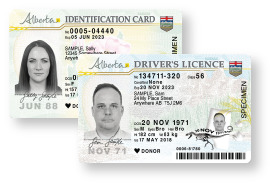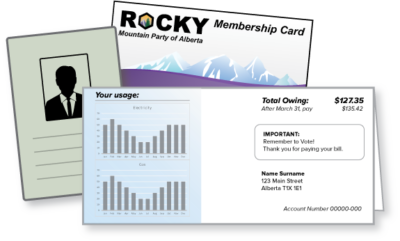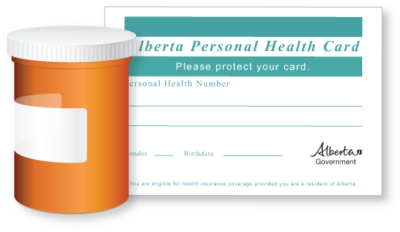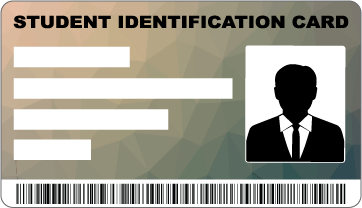ID Required To Vote
To do this, you may:
- Provide one piece of Government-issued photo ID, including your full name, current address, and photo
- Provide two pieces of ID, both containing your full name, and with one showing your current physical address
- Have another registered elector in your voting area vouch for you
- Have an authorized signatory complete an attestation form
See what we accept below:
One Piece of Identification

Your Alberta Driver’s Licence or Identification Card can be shown as one piece of ID, if it has your full legal name and current physical address.
If you have an alternate piece of ID issued from a local, provincial, or federal government or an agency of that government that includes your name, physical address and photo, it can also be accepted as one piece of identification. A passport cannot be used as one piece of identification as the address is handwritten by the individual.
If your Driver’s Licence or Identification Card does not have your current address, you may use it as one piece of ID, in combination with another piece of ID showing your current physical address.
Driver’s Licences and Identification Cards only containing a mailing address (e.g. PO Box)
- If you registered to vote at your current physical address, you do not need to provide additional identification and can use your Driver’s License or Identification Card which contains your current mailing address;
- If you are not registered to vote, or need to register at a new physical address, you will need additional identification to prove your physical address (i.e. legal land description, lot-block-plan, or 911 address) prior to voting.
Two Pieces of Identification
When showing two pieces of ID, ensure that both contain your full name and that one piece shows your current physical address. Over 50 different types of identification can be presented to vote, expand the list below to view all the options.
Vouching
Electors without identification can be vouched for by another elector in their voting area if the vouching elector:
-
- Has either one-piece or two-pieces of identification, as outlined above; and
- Signs a declaration stating that they personally know the elector, that they are a qualified elector, and believe the elector resides at the physical address provided by the elector.
The elector being vouched for must also sign a declaration to declare that they have not previously voted in the election and they are a qualified voter.
Voucher’s must attend the voting place with the elector that they are vouching for.
What is a Voting Area?
The 87 electoral divisions in Alberta are sub-divided into voting areas for the purpose of administering the election. When you vote on Election Day, the voting station that you visit is dedicated to your voting area. There are 4764 voting areas in Alberta.
Vouchers and the elector being vouched for should confirm that they are in the same voting area before arriving to vote to ensure that the voucher is eligible to vouch for the elector. Voting areas are displayed on the electoral division maps and are listed on the Where to Vote Cards mailed to all households. Electors may also contact Elections Alberta at 1.877.422.8683 to determine their voting area.
If the person vouching for you is in the same household, they are in the same voting area. If the person vouching for you is a neighbour, they may or may not be in the same voting area, as boundaries often cut down the middle of roads, meaning that odd and even houses on the same road may be in different voting areas.
Is there a limit on the number of people that one person can vouch for?
There is no limit on the number of electors that an elector can vouch for.
Once I have been vouched for, can I vouch for someone else?
An elector who has been vouched for cannot vouch for another elector, as the process requires the vouching elector to have identification.
Attestation
Attestation Forms are authorized by the Chief Electoral Officer to be used as a form of identification in the following circumstances:
- An elector who resides in a supportive living or long-term care facility**,
- An elector who resides on a colony,
- An elector who resides on a First Nation or Metis Settlement,
- An elector who resides in student housing on a campus in Alberta,
- An elector who is an inmate,
- An elector who receives services from a shelter or community support centre**,or
- An elector who is renting their ordinary residence.
To use an Attestation Form as ID, the elector will:
- Download and print the applicable form from the table below.*
- Complete section 1 of the form, which includes name, address, and signature fields,
- Contact one of the authorized signatories, as identified in the table below and provide them with the form. The authorized signatory will complete section 2 of the form.
- Bring the completed form to the voting place and present it to the Voting Officer at your voting station. The Voting Officer will retain the Attestation Form.
The attestation process is completed before attending a voting place. The authorized signatory does not need to attend the voting place with the elector.
| Attestations | Authorized Signatory |
|---|---|
| Elector in Supportive Living or Long-Term Care | Facility Operator or Manager, Recreation Director or Manager, Registered Nurse |
| Elector Living on Colony | Colony Manager, Colony Minister |
| Elector Living on Reserve or Settlement | Chief, Band Manager, or Membership Coordinator; Settlement Chair or Administrator |
| Elector Receiving Services From Shelter or Community Support Centre | Shelter or Housing Administrator (who has strong familiarity with regular clientele) |
| Incarcerated Elector | Correctional Service Worker, Correctional Officer |
| Student Living in Residence | Student Residence Coordinator or Housing Services Administrative Staff |
| Tenant Elector | Titled Land Owner, Lessor, On-Site Caretaker, Third-Party Management Administrator |
*During an election or by-election, Elections Alberta also shares the form and information on how to use it with facility operators of supportive living and long-term care accommodations, colony managers, First Nation Chiefs, Métis Settlement Administrators, shelter and housing administrators, liaison officers at correctional facilities and penitentiaries, student residence staff, student associations, public libraries and the Alberta Association for Immigrant Serving Agencies. Forms can also be obtained from Elections Alberta or any Returning Office.
**Electors who reside at a supportive living facility, long-term care facility or a shelter or who receive support or services from a community support centre may also vote at a mobile voting station established for that facility. These electors are acknowledged by an official of the facility to be resident or receiving services and are not required to show any identification. They are deemed resident in the electoral division in which the facility is located. See Mobile Voting for more information on this voting option.





